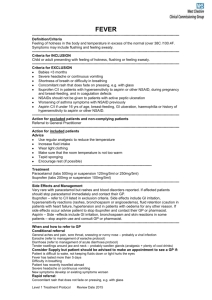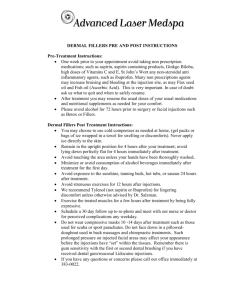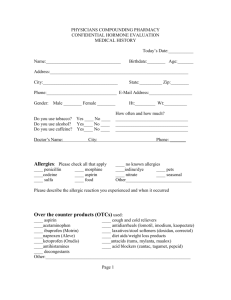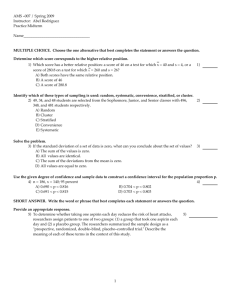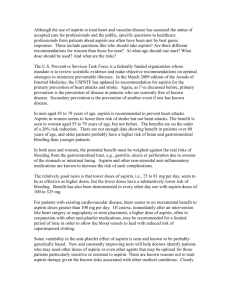File
advertisement
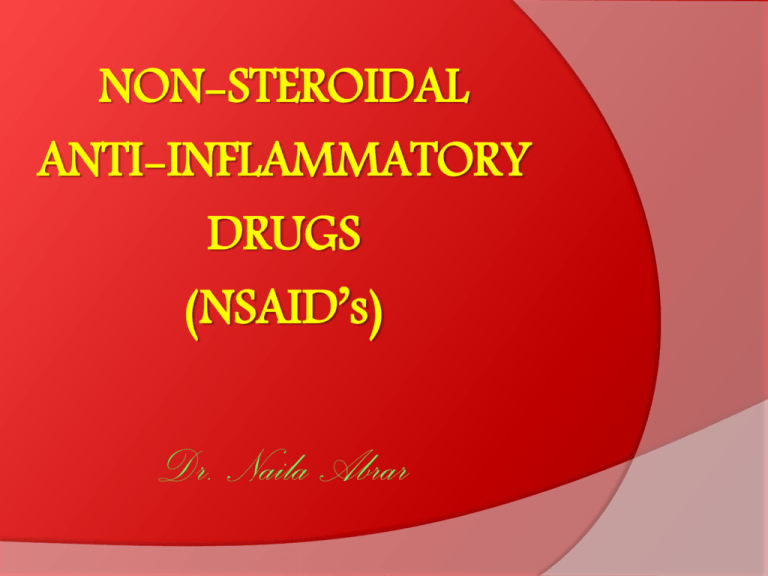
NON-STEROIDAL ANTI-INFLAMMATORY DRUGS (NSAID’s) Dr. Naila Abrar LEARNING OBJECTIVES After this session, you should be able to: recall the pathophysiology of inflammatory response; classify NSAID’s; know the common features of NSAID’s; describe mechanism of action of NSAID’s; and discuss pharmacokinetic features, mechanism of action, pharmacological effects, adverse effects and clinical pharmacology of aspirin. THE INFLAMMATORY RESPONSE Immune response INFLAMMATION Normal / Abnormal Calor Dolor Rubor Tumor Loss of function FUNCTIONS OF COX COX-1 Constitutively expressed Housekeeping functions Present in every organ stomach, intestine, kidney, platelets, vascular endothelium COX-2 Inducible Inflammatory & neoplastic sites Also present in kidney, uterus. ovary brain, small intestine PGE2 Protection of GI mucosa Temperature homeostasis : Mediator of fever PGI2 (prostacyclin) Vasodilation Inhibit platelet aggregation Vasodilation Renin release & natriuresis Contraction of uterus Lower threshold of nociceptors Lower threshold of nociceptors PGF2 Uterine function, labor Bronchoconstriction PGD2 Regulation of sleep wake cycle Bronchocontriction Vasodilation TXA2 Vasoconstriction Platelet aggregation Bronchoconstrictio n Mechanisms associated with peripheral sensitization to pain PAIN: an unpleasant sensory or emotional experience 2 clinical states of pain: Physiological (nociceptive) pain direct stimulation of nociceptors Neuropathic (intractable) pain result from injury to the peripheral or central nervous system that causes permanent changes in circuit sensitivity and CNS connections PERIPHERAL SENSITIZATION TO PAIN CGRP CGRP Gate Control Hypothesis: Interneurons activated by Ab fibers act as a gate, controlling primarily the transmission of pain stimuli conveyed by C fibers to higher centers. Rubbing the skin near the site of injury to feel better Transcutaneous electrical nerve stimulation (TENS) Dorsal column stimulation Acupuncture ANALGESICS 1) 2) 3) 4) Act at the site of injury and decrease the pain associated with an inflammatory reaction (e.g. NSAIDs) Alter nerve conduction (e.g. local anesthetics): block action potentials by blocking Na channels Modify transmission in the dorsal horn (e.g. opioids) Affect the central component and the emotional aspects of pain (e.g. opioids, antidepressant) SITE OF ACTION Sensation of pain NSAID’s Signal transmitted via spinothalamic pathways to contralateral thalamus & cortex Activation of AMP receptors in dorsal horn of SC Increased sensitivity of peripheral nociceptors Local release of inflammatory mediators Injury WHO Analgesic ‘Ladder’ Severe Moderate Mild Step 3 Strong opioids (e.g., morphine) with or without non-opioids Step 2 Weak opioids (e.g., codeine) with or without non-opioids Step 1 Non- opioids (e.g., NSAIDs, Acetaminophen) CLASSIFICATION (chemical) SALICYLIC ACID DERIVATIVES Aspirin Sodium salicylate Methyl salicylate Choline salicylate Magnesium salicylate Diflunisal Benorylate CLASSIFICATION (contd.) PARA-AMINO PHENOL DERIVATIVE Paracetamol ACETIC ACID DERIVATIVES Indomethacin Diclofenac Etodolac Sulindac Ketorolac Tolmetin Nabumetone CLASSIFICATION (contd.) FENAMIC ACID DERIVATIVES Mefenamic acid, meclofenamate sodium PROPIONIC ACID DERIVATIVES Ibuprofen, naproxen, fenbufen, fenoprofen, flurbiprofen, ketoprofen ENOLIC ACID DERIVATIVES Piroxicam, meloxicam (oxicams), CLASSIFICATION (contd.) PYRAZOLON DERIVATIVES Phenylbutazone, azapropazone, oxyphenbutazone COX 2 SELECTIVE Celecoxib, etoricoxib, rolicoxib, lumaricoxib, valdecoxib, PROPERTIES OF NSAID’s Common general properties Common mechanism of action (cyclooxygenase inhibition) Common therapeutic indications Common adverse effects Different pharmacokinetics and potency Different chemical families Different selectivity's to COX I and II Similarities more striking than differences General properties in common: Organic acids EXCEPT nabumetone Well absorbed Strongly protein bound Highly metabolized Renal excretion mainly Varying enterohepatic circulation Distributed in synovial fluid MECHANISM OF ACTION Membrane phospholipids Corticosteroids Phospholipase Arachidonic acid COX Lipoxygenase Leukotienes Prostaglandins Thromboxane NSAIDS Prostacyclin ADVERSE EFFECTS OF NSAID’S CNS 2. CVS 3. GIT 4. HEMATOLOGIC 5. HEPATIC 6. PULMONARY 7. RASHES 8. RENAL 1. Aspirin (Acetylsalicylic acid; ASA) Willow bark- Salicin Synthesized in 1853 Organic acid Ester of acetic acid COOH OOCCH3 HISTORY Salicylic acid-natural product, present in the bark of willow and poplar trees 18th century – Salicin - oxidized to Salicylic acid In 1828 a Swizz pharmacist, Lowig, distilled meadowsweet flowers and got salicylaldehyde 1897, a chemist at the Bayer Company worked on acetylsalicylic acid effect profile to improve adverse The name Aspirin was coined by adding an a for acetyl to spirin from the name of the plant meadowsweet (Spiraea ulmaria) from which salicylic acid was first isolated Pharmacokinetics Rapidly absorbed from stomach and upper small intestine Hydrolyzed to acetic acid and salicylate by esterases in tissue and blood Bound to albumin ZERO ORDER KINETICS Conjugated in liver and cleared by kidney Excretion: 25 % excreted unchanged & 75 % as metabolites in urine ,enhanced by ALKALINIZATION t1/2 15mins but antiplatelet action 8-10 days Mechanism of Action Inhibits both COX-I and COX-II Anti-inflammatory Analgesic Antipyretic Aspirin irreversibly inhibits platelet COX Anti-platelet effect (lasts 8-10 days) Anti –inflammatory effect Inhibits PG synthesis at the periphery Inhibition of granulocytes adherence to damaged vasculature Stabilizes lysosomes Inhibit migration of polymorphs and macrophages at site of inflammation Interferes with chemical mediators of kalikrein system Inhibition of antibody production Analgesic Effect Reduces mild to moderate pain of varying cause (pain of musculoskeletal structures) relieved better than of visceral origin Mainly acts at periphery at nociceptive level so effective in pain associated with inflammation (pain of muscular, vascular & dental origin, postpartum states, arthritis & bursitis is relieved) Also inhibits pain stimuli at a sub-cortical level Antipyretic Aspirin reduces only elevated temperature & has no effect on normal temperature Aspirin resets the temperature regulating centre to normal by inhibition of PGE2 synthesis Blocks the action of IL-1 released from macrophages by action of bacterial endotoxins / inflammation Vasodilatation of superficial blood vessels causing inc. dissipation of heat Antiplatelet effect Aspirin in small doses decreases platelet aggregation by suppressing the synthesis of thromboxane A2 It irreversibly acetylates the COX Effect lasts for 8 – 10 days till new platelets are regenerated High doses suppress prostacyclins also & platelet inhibitory effect is lost Effect on GIT a. b. Vomiting-- Stimulation of CTZ Dose related gastric ulceration & hemorrhage, due to inhibition of protective PGI2 Ischemia of gastric mucosa Increased gastric acid secretion Inhibition of gastric mucous secretion Misoprostol –may prevent GI ulceration Other effects Uricosuric action: In high doses above 4 gms CVS a) b) c) d) In therapeutic doses, no effect In large doses--- Peripheral vasodilatation In toxic doses--- Vasomotor paralysis Edema , HTN in pts with activated reninangiotensin sytem Respiration: a) b) c) In therapeutic doses, Increased depth of resp. In large doses-Compensated resp. alkalosis In toxic doses - Uncompensated resp. acidosis Renal Nephropathy Pregnancy Prolongation of gestation & inhibition of labor Hypersensitivity (not immunologic but due to PG inhibition) DOSAGE Analgesic –antipyretic effect :324 to1000 mg 4-6 hourly Antiplatelet effect: Prevention of stroke and MI 75-150 mg inhibits platelet aggregation Anti-inflammatory effect: 3-4gm/d Acute rheumatic fever, 0.9-1.2 g every 4 hourly max of 8 gm THERAPEUTICS USES OF ASPIRIN ANALGESIA (moderate dose) Aspirin is one of the most frequently used analgesic For mild to moderate pain Severe pain is not controlled by aspirin a. Used alone in pain like: Headache, myalgia, arthralgia, neuralgia, osteomyelitis, osteoarthritis, toothache, dysmenorrhea b. With opioids – synergistic action In pain of cancer metastases in bone Post operative pain- requirement of opioids ANTI-INFLAMMATORY (in large doses) Rheumatoid arthritis Acute rheumatic fever along ē benzyl penicillin ANTI-PYRETIC All fevers but not effective in raised body temp. due to heat stroke or malignancy AS ANTI-PLATELET (in low doses 75 – 300mg/day) For TIA & cerebrovascular stroke Prophylaxis of unstable angina, MI Thrombosis after coronary artery by pass grafting URICOSURIC AGENT (large doses >4 gm /d) CLOSURE OF PDA LOWERS INCIDENCE OF COLON CANCER Niacin- flushing Bartter syndrome Astringent action to remove warts, corns Methylsalicylate (oil of wintergreen) Systemic mastocycosis ADVERSE EFFECTS OF ASPIRIN 1. Gastric upsets: Erosive gastritis & Gastric ulceration Hematemesis Melena Occult Blood In stool Dyspepsia and heart burn Nausea & vomiting 2) Effects on CNS Salicylism: (In large doses): Tinnitis, deafness, dimness of vision, dizziness, ataxia, mental confusion, vertigo, nausea & vomiting, sweating, thirst (In Toxic Doses): Hyperpyrexia, CV collapse, convulsions, ketosis, coma 3) Related to Kidney: Analgesic Nephropathy 4. Respiratory system Hyperventilation –respiratory alkalosis Compensated respiratory alkalosis (high doses) Respiratory acidosis Uncompensated metabolic acidosis (toxic doses) 5. Blood Hypoprothrombinaemia Increase bleeding tendency 6. Allergic / Hypersensitivity Reactions Bronchospasm Urticaria Rhinitis Hay Fever Aspirin Toxicity Salicylism Neurological effects Acid-base balance & electrolytes CV effects Metabolic effects Management of aspirin/salicylate overdose toxicity/poisoning Gastric lavage Activated charcoal Correct fluid, electrolyte & acid base balance Maintain high urine out put Keep airway patent Body temp. by cold sponging Vit. K I/V to correct hypopthrombinemia Diazepam I/V for convulsions Promote excretion of salicylates by NaHCO3 I/V to alkalinize urine ,maintain pH at 8.0 1. Hemodialysis in pts. with severe acidosis & coma 1. 2. 3. 4. 5. 6. 7. 8. 9. DRUG INTERACTIONS Concomitant NSAID’s & low dose aspirin ACE inhibitors Warfarin Sulfonylurea hypoglycemics Methotrexate DICLOFENAC Phenylacetic acid derivative More selective for COX-2 Short t1/2 Combinations are available (+ misoprostol) 150 mg/d impair renal blood flow & GFR GI ulceration less frequent Elevation of serum aminotransferases Preparations: eye drops, topical gel, suppository Dose: 50-75mg qid IBUPROFEN Phenylpropionic acid derivative Anti inflammatory effect start at 2400 mg/dl (equivalent to 4gm aspirin anti-inflammatory effect) Lower dose has analgesic effect Closure of patent ductus arteriosus in preterm infants Less decrease in urine output, less fluid retention Decreases antiplatelet effect of aspirin Oral I/V, topical INDOMETHACIN Indole derivative Potent non-selective COX inhibitor and may also inhibit phospholipase A and C Reduce neutrophil migration and decrease T-cell and B-cell proliferation Effective in joint pain, swelling & tenderness Gout Accelerate closure of patent ductus arteriosus Relaxes smooth muscles Pancreatitis, frontal headache t1/2 prolonged by probenicid ACETAMINOPHEN Active metabolite of phenacetin Weak COX-I and COX-2 inhibitor Inhibits COX-3 No significant anti-inflammatory effects Pharmacokinetics: Peak blood level is reached in 30-60 min Metabolized by hepatic microsomal enzymes and form acetaminophen sulfate and glucronide N-acetyl-p-benzo-quinoneimine(NAPQI)Toxic to liver and kidneys Indications 325 – 1000mg (total dose not > 4000mg) Headache, myalgia, postpartum pain In rheumatoid arthritis with antiinflammatory agent Preferred to aspirin in peptic ulcer, in children with viral infections Adverse effects Mild increase in hepatic enzymes Dizziness, excitement & disorientation at larger doses Toxic dose: 10-15gm 20-25 gm potentially fatal (? tablets) NAPQI reacts with sulfhydryl gps in GSH normally & then excreted as mercapturic acid in urine but in toxic dose GSH is depleted and toxic metabolite accumulates Treatment Supportive therapy N-Acetylcysteine COX-2 SELECTIVE INHIBITORS Celecoxib, rofecoxib, valdecoxib, parecoxib, etoricoxib, lumaricixib Inhibit prostaglandin synthesis by the COX-2 isozyme Analgesic, antipyretic and anti inflammatory effects No effect on platelet aggregation No cardioprotective effect CELECOXIB Highly selective COX- 2 inhibitor Half life is 11 hrs Metabolized mainly in the liver Effective in rheumatoid arthritis and osteoarthritis Less production of peptic ulcer Inhibit COX 2 mediated prostacyclin synthesis in vascular endotheliumplatelet aggregation Differences Non-selective vs COX 2 Selective Lesser GI adverse effects No impact on platelet aggregation Increased risk of thrombotic events;MI & stroke Increased likelihood for hypertension & edema Thank U!


